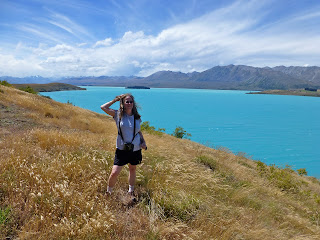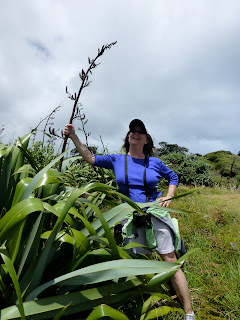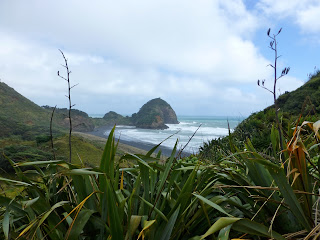Stuff is expensive in New Zealand. Books are expensive,
clothes are expensive, and food is expensive. But no one expects a tip, and everyone is paid a
livable wage, with the minimum set on high. I do not know all the economic
implications of the high price of food, but suspect that one culprit is that,
unlike in America, ¾ of the menu is not made entirely out of federally
subsidized corn syrup, and the lamb and beef originated as actual self-propelled
animals, rather than hybridized
meat-units bred square to economize on space. Plus, anyone who wants to can pluck
her own fruit salad from right outside her window. I saw no evidence of extreme
poverty or extreme wealth. Those might be related observations.
over time a whole lot of our stars have slid down to the southern hemisphere, and
bunched up at the bottom. So it’s a good place to look at stars, unless you’re
hoping to spot ones you know personally. I made a point of finding the Southern
Cross as my friend Dale suggested, even though I was leery that it might be a
huge scary constellation sponsored by the Klan. It wasn’t. It was an unassuming
little number more appropriately called the Cute Little Southern Kite. And I did catch a glimpse of good old Orion loping over from the north, although his
dangling—let’s go ahead and call it his hunting knife—was pointing straight up.
 |
| Lake Tekapo |
Anyway, the whole star thing is such a big deal that they
put up a nice set of telescopes on a prominent hill called Mt. John, just to
keep track of them all. If you stand on top of Mt. John you can see in every direction, and watch gangs of weather jousting for supremacy. We didn’t stay for
the star show. The sun in New Zealand goes down reluctantly and briefly, like
it’s just stepping out for a cigarette. But daytime visitors can comfort
themselves with massive slabs of carrot cake at the hilltop café. Any lighter
desserts would get blown into Lake Tekapo (“Taah-wow-wow”). The astronomers here are especially interested
in flagging down stray planets that might resemble our own. They’d be dim, of
course, but can be detected if alignment is just right when they wobble the
starlight behind them. The ideal would be to wave at another group of
life-forms like us and in the same phase of evolution, just after developing
telescopes and before engineering their own apocalypse. Which gives us probably another hundred years or so, but it’s not like we have anything better to
do. It’s a long shot for sure, but there are a LOT of stars.
In the southerly regions, much of the bush (snort!) looks like Oregon, if Oregon had
parrots and the ferns grew into trees
instead of just on them and
everything smelled like Juicy Fruit. A lot of the plant life is familiar as
specimens that have showed up in Portland nurseries angling to make a buck off
climate change. These are the plants available in two-inch pots with
instructions to tuck them into a protected corner, feed them with an
eyedropper, and read to them on the chillier nights, and if instructions are
followed, the odds were good they’d double in size in ten years. Here, those
same plants had gone Godzilla. One in particular, with great towering stands of
spiky leaves, was especially familiar. I gaped at acres of them and struggled for the
name. “They’re New Zealand flax,” Linda said. Oh yeah! We save up for those and nurture them through two or three seasons until they’re big
enough to be considered viable, at which point we gingerly begin to announce
them to our Facebook friends and sock away for their college educations, and
then on a single winter day they all turn into snot. Which is why they’re not
called Portland flax.
Far from being tucked away in a protected corner, they romp
over the mountains and smirk at the winds. It is very windy in New Zealand.
People plant giant walls of greenery around themselves just so they don’t have
to tack across the yard to get the mail. We stood on a mountain and watched a
rain squall roll in over the ocean, giving us enough time to put on our
raincoats and Ziploc our cameras, and then a single raindrop an acre wide
smacked into the side of the mountain and on into the next territory by the
time we’d zipped up. Couldn’t say how hard the wind blew, because they have
pretend measurements over there. Four thousand kilometers per fortnight, or something.
But it makes peeing an extreme sport. I anchored myself well, and in thirty
seconds my stream never hit the ground, I was air-dried, and had the beginnings
of a Brazilian.
Hey! I’ll be reading from Trousering Your Weasel on Friday, Feb. 8 at 7PM at St. Johns Booksellers in North Portland. I’ll probably read other stuff too. There might be cookies. See you there.




Shoot, woman, menopause has given me the start of a brazilian. I just wish something would finish it off.
Any wider book tour plans, or should I buy a ticket to the left coast?
Book it baby! And I hear you about the "start of the Brazilian." Me too. Although it's not so discriminating about what stays and what goes.
It migrates to other areas – like chin and lip.
Sounds like the wind in Iceland except the cold tends to make things shrink in fear.
In New Zealand, things just swing.
Agreed, Jono. Very Icelandic!
I held it in as long as I could, which was difficult because of all the good lines, but your last six words did me in, and I snorted 🙂
Emission accomplished!
Nothing worse than an undiscriminating Brazilian…aging has few things tougher to deal with, at this point. Your ending took me completely by surprise and I'm still laughing. What great writing. Every sentence. It sounds like a wonderful place.
I've started to notice a few things that are tougher to deal with than a patchy snatch, I'm sorry to say.
Oh, my. I laughed and laughed. Orion upside-down with his… dagger pointing straight up? That I must see.
(Something wonky btw, at the end of the star paragraphs. "gives us probably got another": I think two drafts of a sentence vying for mastery.)
I long to see New Zealand. Ai!
Wonkiness fixed! I give thanks to my sharp readers who also know I'd like to fix these things. And you're right. That's just how it happens. You change the wording a little bit and don't quite get everything deleted. This is what I get for all that fine-tuning.
Now THAT is quite a breeze. Dagger pointing up–I don't understand…
It's not understandable. Orion's dagger is supposed to be hanging.
I'm laughing off my chair right now! Brilliant post Murr!
I can't believe I've been to New Zealand twice… and I NEVER saw a single Kiwi-fruit tree!!! Epic fail! :o(
I did see a Kiwi-bird though… three in fact! ;o)
Orion definitely looks weird backwards… and the Southern Cross is a lot less impressive than I expected. But cute is a good word for it!
Oh, well, you scored. I would have rather seen a kiwi bird than a kiwi fruit. And the Southern Cross–I know, right? It's so dinky. Perfectly fine kite, and even has a nice kite tail, but that's not supposed to be part of it.
This comment has been removed by the author.
I've been following your New Zealand posts with great vicarious pleasure (had to recover from Marbles first and that last awful post about old and dilapidated postal workers???). To me, the star gazing sounds like a peak life time experience and I'm so happy you had this trip! Patchy snatch? The fact that this stuff just flows from your brain to your blog? I get vicarious pleasure out of that, too. I used to blog…thinking of taking it up again.
You just reminded me of a time I was a little kid and we were in North Dakota and Daddy got me out of a sound sleep to go outside (we were at Grandma's farm) and look at the northern lights. I do remember that, because I was so sleepy and it was so pointless, but no northern lights. Now I realize I was already very myopic (I couldn't see stars either) and nobody realized it until I was eight. I remember when you blogged. Do it! (I also remember when you played Lexulous.)
Hey! You brought Haystack Rock along! That's so sweet.
Best post ever, as usual. Have you considered doing stand-up? Just so many laugh lines.
[Reposted 'cause I put it in the wrong place.]
Closest thing might be (one never knows) my reading at St. Johns Booksellers. We'll see!
Just about fell off the chair laughing when I read the last two sentences! You're the bright spot of my day.
Oh goody! I hope something nice happens to you the other five days of the week.
I love this post so much.
But my favorite sentence was, "The sun in New Zealand goes down reluctantly and briefly, like it’s just stepping out for a cigarette."
That was absolutely brilliant.
Good! You're not an adverb nazi.
HA! Nope!
That was an outright snort! Startled my cat!
You should be a teacher. I learned more about New Zealand tonight than I could have in a dozen texts.
Was clueless about the Briazlian, until I read on. Scares me how much I didn't know before I started read to read your blog!
'er, a Brazilian…
Can't wait to tell my friends! They might be clueless, too.
I can't help but notice that a lot of what you might learn from Murrmurrs is not exactly what a person needs to know. For instance, I just read that 80% of college students (of all sexes) routinely shave their curlies. It's leading to a devastating drop in the public lice population.
The kiwi crown is fetching. And the portrait of flax with knockers is wonderfully well lighted. Bravo! If you can still squat to pee, you are in better snap than I am, patchy snatch and all. Shaving? Hell of a place to get razor burn!
Oh I think the little darlings wax. However, the same observation (hell of a place to…) applies.
Hah! Sorry Murr, still laughing as this: "I anchored myself well, and in thirty seconds my stream never hit the ground, I was air-dried, and had the beginnings of a Brazilian." Travel more often please. Seriously. How can we miss you if you won't go away? Roth x
Ooo Dan Hicks! That's one of my favorite songs.
You sold me on New Zealand. I'll probably never make it there, but now I'd almost like to pack up and move. ….but then there's the rest of the family. Guess I'll be staying here unless the whole lot of them decide they'd like to go too.
Lee
Wrote By Rote
An A to Z Co-host blog
You could have THEM read this too. That should seal it. Y'all do have to like sheep. Like that famous Christmas song: "Oh we like sheep."
"For instance, I just read that 80% of college students (of all sexes) routinely shave their curlies. It's leading to a devastating drop in the public lice population."
Can lice on one's privates be public?
Oh crap. Now I need an editor for my COMMENTS! I knew it would come to this. Incidentally, that is a true story.
I can never get over how well you write, Murr. Especially for an ex-mail carrier.
Hey, wait a minute. Maybe you got so good because you read everybody's mail and learned what and what not to do.
Like, I learned not to come to the bottom of a page in the middle of a sentence and then write:
(TURN OVER)
as if the reader wouldn't have figgered it out on his own.
Glad you're enjoying our neighbour. It's a beautiful place.
Linda raved about YOUR place. I think the weather would get to me but oh my do you have wonderful things to look at. And I will have you know that a magpie was one of the first birds I recognized in NZ. The tail wasn't really as long as ours, but otherwise unmistakable. A fine bird all around.
Thank you. My black and white brothers are not native to New Zealand. We were introduced to eat pesky insects about 150 years ago.
Love the account of the pathetically wimpish and effete Portland flax. The New Zealand equivalent obviously benefits from testosterone-rich soil.
The unintentional Brazilian has clearly caught your readers' imagination. Fortunately my dearly beloved has never asked me to despatch my snatch.
As someone mentioned earlier, I'm developing my own screwy version of the Brazilian all by myself.
I would so love to visit New Zealand, but only with you as my tour guide, Murr! 🙂
No no no! You want Linda.